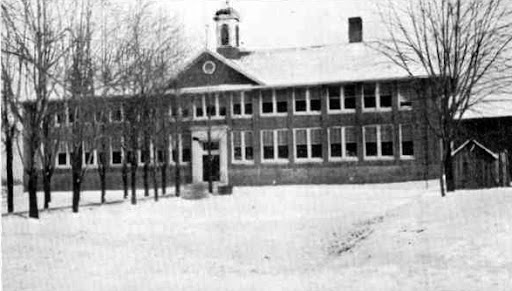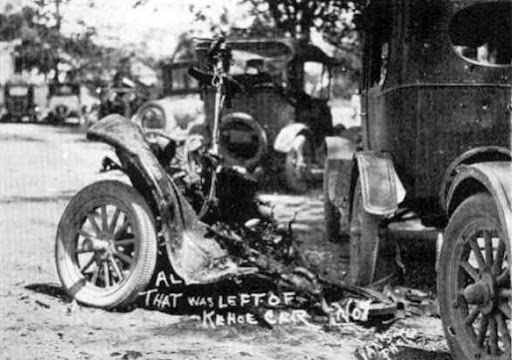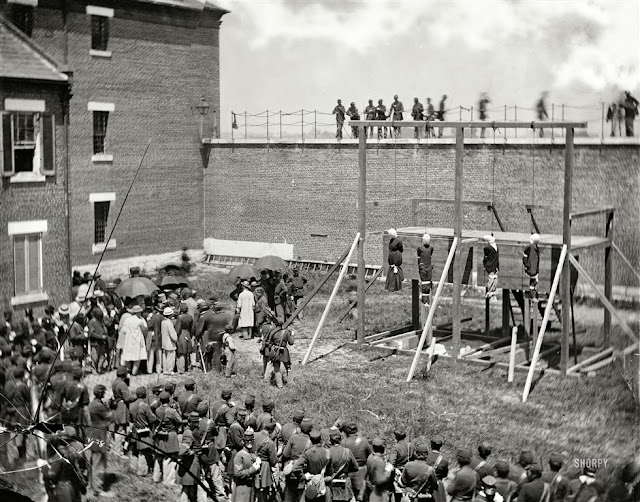
Bath Township Consolidated School in 1927 prior to the bombing. Note the cupola atop the school later to become a memorial.
Ninety-eight miles outside of Detroit, just west of Lansing, near to where the world's first automobiles were manufactured there stands the small Midwest town of Bath, Michigan. This sleepy community in Central Michigan betrays no sign of it's disturbing historical significance.
In 1927, Bath's exuberant and triumphant pre-Depression American spirit shockingly gave way as the town became a horrifying scene of the destructive rage of a single deranged man. This event would set two gruesome historical precedents. One, in 1927, Bath MI. became the birth place of the car bomb. And Two, when the dust settled 45 were dead making Bath the scene of the largest mass murder of civilians in American history prior to World War Two.
Bath far out-weighs the mass shootings at Virginia Tech or the Fort Hood massacre that have occurred in recent years making it second only to 9/11, the Newtown Massacre in Connecticut in 2012 and the Oklahoma City Bombing in it's indiscriminate, murderous scope.
It's important to note that although 45 lost their lives in the blink of an eye - not a single shot was fired. These victims, of which almost all were school aged children, were killed by a mixture of dynamite and a military grade explosive known as pyrotol, an early precursor to napalm used in World War One. Another 58 would survive only to be brutally maimed.

Bath Consolidated School after 500 pounds of dynamite and pyrotol exploded in the basement. Another 500 pounds was found miraculously undetonated.
This weapon was unleashed in the pre-suicide frenzy of Mr. Andrew Kehoe, a disgruntled farmer, who shortly before his death became the most prolific mass murderer in U.S. history.
At 9:45 AM on the morning of May 18th 1927 a very carefully wired alarm clock went off inside a sleek new school in a sleepy Central Michigan town. When it did, it signaled the end of an era in American history.

The Hall siblings Wila and George Jr. were killed in a Timothy McVeigh styled terrorist bombing of a central Michigan school in 1927.
The tiny electric pulse reached out from the small battery and ignited 500 pounds of dynamite, the equivalent of localized earthquake, demolishing the north wing of the school and instantly killing dozens of innocent children in the blast. Among those killed in the explosion or from horrific injuries were the Hall siblings Wila and George Jr. (pictured above), the Hart siblings Iola and Percy, the Zimmerman brothers ages 8 and 10, Fifth grade teacher Mrs. Elizabeth Harte who died with her three nieces and nephews in the explosion.
A neighbor of Kehoe, who would later write an account of the Bath Township Bombing, Monty Ellsworth reported that after the explosion Kehoe was grinning from ear to ear as he raced towards the disaster scene in the world's first car bomb. What neighbor Ellsworth didn't know at time was that Mr. Kehoe had just bashed Mrs. Kehoe's brain's in then set his own home aflame.
At Bath Consolidated School, as the stupefying shock of the bomb blast wore away, rescuers poured over the rubble and some noticed smoke in the distance. What many did not notice was a small man with a determined expression on his face as he pulled up to the disaster scene. The middle-aged man motioned over to what we refer to today as "First Responders". A few of them walked over to Kehoe's Model A.
Among these men was a man who no doubt would have recognized the euphoric, grinning man in the vehicle as Andrew Kehoe. This man was one of the primary targets of Kehoe's murderous wrath and also one of the last who would die that day - Bath School Superintendent Huyck.

The Kehoe car bomb was loaded with enough explosive to vaporize 75% of his vehicle killing Kehoe and three others.
Witnesses report that the third and final explosion of that day, a car bomb utilizing the same dynamite that demolished the school, killed Superintendent Huyck, Postmaster Glenn O. Smith and Smith's father-in-law Nelson McFarren. All that was left of Kehoe's car was a tire and twisted metal shards.
The inexplicable, all-consuming fury of Kehoe claimed the lives of 45 people. Of that number, 38 were school children in grades 7-12 when Andrew Kehoe, acting as a volunteer and school janitor, secretly loaded the school full of dynamite and an incendiary explosive known as pyrotol.
Pyrotol was a military grade explosive that once ignited worked much like modern day napalm - burning ferociously. In World War One, American soldiers used this incendiary agent to burn enemy regiments out of trenches w/dire results.
Miraculously, another 500 pounds of explosive were found undetonated in the south wing of the school - only a miracle saved the entire site from being a smoking pile of rubble with the broken bodies of children roasting in pyrotol.
Bath Bombing survivor Donald Huff who passed away in March of 2011 at age 93, recalls that as a fourth-grade student student he had been one of the most severely-injured survivors of the bombing yet still managed to live into his 90's. Huffman spoke candidly about being inside one of class rooms in the north wing that day:
The school explosion made front page headlines of national newspapers, sharing the page with news of Charles Lindbergh's trans-Atlantic flight. Senator James Couzens of Michigan gave generously to the fund, and on August 18th 1928 a new school was built on the same site. The James Couzens Agricultural School stood for 50 years before being torn down in 1975 and another school built on another location.

The cryptic sign that greeted firefighters at Kehoe's burned down farm.
The Bath School Bombing remained the worst bombing in U.S. history until Timothy McVeigh set off a truck bomb in front of the Alfred P. Murrah Federal Building in Oklahoma City, Oklahoma, on April 19th 1995.
The survivors, mostly children during the attack, became extraordinarily long-lived people - some living well into their 90's. Those, like Donald Huffman, survived but were horribly physically scarred by the bombing. As if in compensation from a God who arrived late for the party, Huffman and others grew remarkably stronger spiritually - as if re-telling their tales of encountering a mad man's rage made them love Life that much more in the telling.
The final word about the Bath Township Bombing is due to William Cressman, who was a 9-year-old fourth grade student at the time that the dynamite exploded directly below his country classroom:


